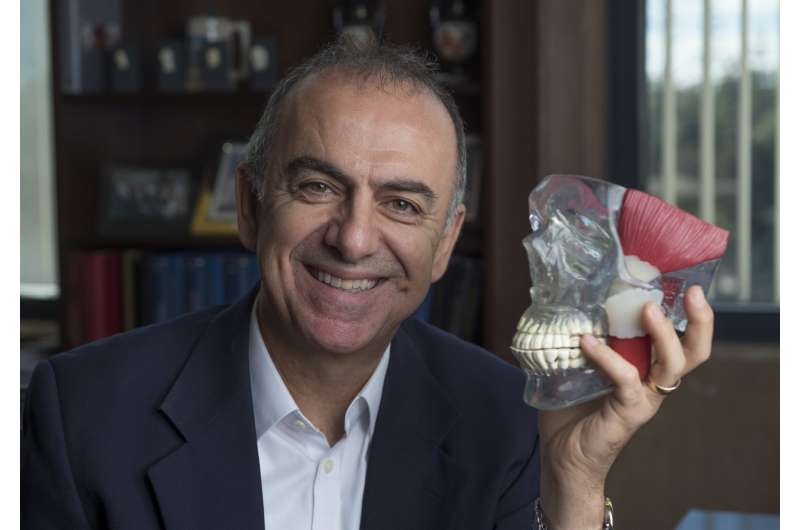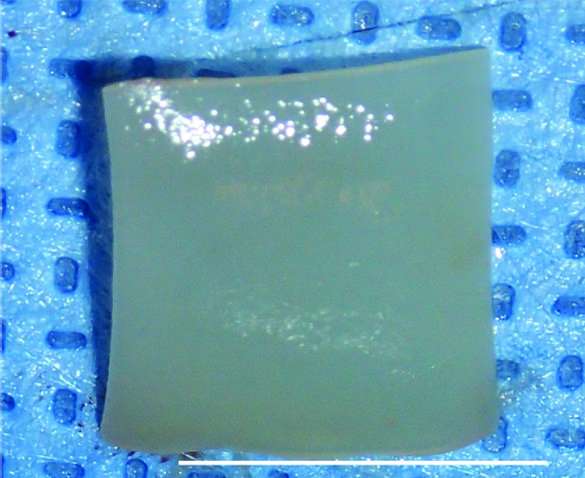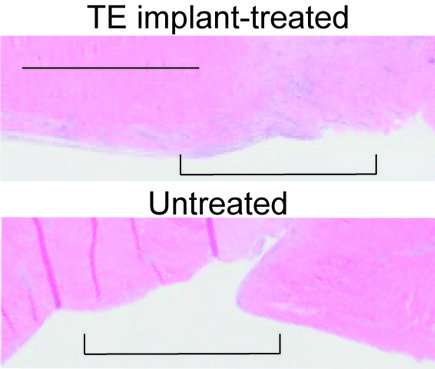Breakthrough treatment for crippling jaw disease created

A first-ever tissue implant to safely treat a common jaw defect, known as temporomandibular joint dysfunction, has been successfully tested by UCI-led researchers in a large animal model, according to new findings.
"We were able to show that we could achieve exceptional healing of the TMJ area after eight weeks of treatment," said UCI distinguished biomedical engineering professor Kyriacos Athanasiou, senior author on the study published in Science Translational Medicine. He has spent nearly two decades researching the condition and potential treatments, since learning the widespread extent of the problem.
About 25 percent of adults worldwide—90 percent of them premenopausal women—suffer from difficulty eating and talking, chronic mouth pain, arthritis and other issues due to defects in the cartilage disc that hinges together two key jawbones.
Now, using animal models, the scientists at UCI, UC Davis and University of Texas Houston School of Dentistry have successfully removed a tiny bit of existing rib tissue, isolated its cartilage cells, and used them to tissue-engineer jaw disc cartilage using a "self-assembling" process they developed. They then surgically inserted the new cartilage into the faulty hinge point of the jaw joint. The approach was allogeneic, meaning that they took rib cells from one individual and implanted the new cartilage into another. Eight weeks later, the defects were completely gone.

"This is a terrible condition, I have friends and colleagues who have suffered from it, so it's extremely satisfying to think we could provide relief," said co-author Jerry Hu, UCI principal design engineer, who developed a critical stage of the work, which involved reining in the sometimes "poorly behaved" rib cells into smoothly functioning jaw disc cartilage.
Researchers and physicians have struggled for decades to effectively treat TMJ afflictions. One infamous technique involved putting Teflon into the jaw area, which disintegrated into bits in the brain and elsewhere. "It was a disaster," said Athanasiou. After hearing about that and a subsequent dearth of research, he plunged in, first at UT, then at Rice, UC Davis and now at UCI.
The next steps will be to ensure long-term effectiveness and safety of the implant in the animals, and then conduct clinical trials.
"We hope this will lead to new treatments for humans," said Natalia Vapniarsky, a veterinary pathologist in the UC Davis School of Veterinary Medicine, where the surgery was done. "Most medical management approaches for TMJ disc issues currently aren't curative, but palliative. Patients come back needing further help, but by that time, the disc and joint are destroyed beyond repair, so all that can be offered is a prosthetic. We wanted to explore an earlier, regenerative solution."

Orange County, a biomedical hub where UCI is located, is the perfect location for translating the breakthrough work into a usable product, Athanasiou said. He and Hu explained that while it might be possible to take someone's own rib tissue and grow it, it would require a lengthy delay compared to using readily available implants. Unlike other tissues and organs, cartilage from one body is not rejected when it is implanted in another body.
Athanasiou said that the results might also apply to treatment of hip, knee and other problem areas. The animals that did not receive the cartilage implants saw a 300 percent increase in osteoarthritis, which many TMJ patients eventually develop, while the treated ones did not.
"This is the first time that cogent healing has been shown in the TMJ area, and, I daresay, the first time anyone has shown successful biomechanical healing in any joint. It's key that we can achieve regeneration of an ailing tissue with our engineered implant, one that's mechanically suited to withstand stresses," he said. "So we believe this represents an important first in all joint healing studies."
More information: N. Vapniarsky el al., "Tissue engineering toward temporomandibular joint disc regeneration," Science Translational Medicine (2018). stm.sciencemag.org/lookup/doi/ … scitranslmed.aaq1802

















